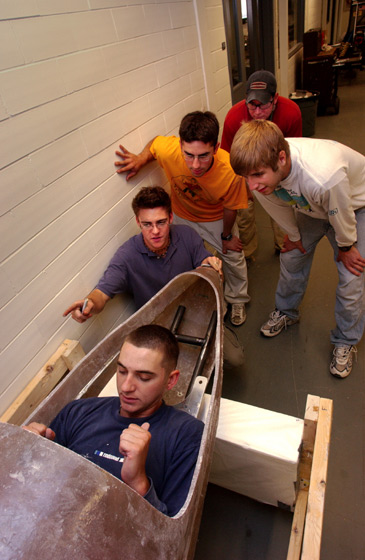Nine senior mechanical engineering majors are designing and manufacturing a human-powered submarine this semester. The vessel will compete June 23-27 at the seventh annual International Submarine Races hosted by the Naval Surface Warfare Center’s Carderock facility in Bethesda, Md.
The group is working under the guidance of Steven Nesbit, associate professor and head of mechanical engineering.
“Since I am interested in pursuing mechanical design after college, this project is a great introduction to my field,” says Dylan Noyes of Bath, Maine. “Everything from learning how to work well in a group, to carrying out the design process, to applying knowledge gained in classes has benefited me for the next step in life.”
Other members of the senior design class are Adam Belles of Ballston Spa, N.Y.; Joseph Carson of Bordentown, N.J.; Adam Foltz of Lebanon, Pa.; Matthew Marsh of St. Louis, Mo.; Tyler Myers of Chambersburg, Pa.; Andrew Rogers of Annapolis, Md.; Roger St. Ours of Saco, Maine; and Matthew Tomik of Salt Point, N.Y.
“Participating in a design project that goes from sketches on a chalkboard to a vessel racing underwater in ten months is amazing,” says Rogers, noting that teamwork has played an essential role in the design of the submarine. “We decided early on to split into three separate design teams. Working in these smaller groups helped each of us develop our own ‘specialty,’ or expertise in a certain system of the submarine. It also ensured the timely completion of our project.”
The group’s submarine, approximately 9.5 feet long and 2.5 to 3 feet in diameter, will compete in a 30-foot underwater course. Times will be recorded every ten meters to determine the speed of the vessel during its 100-meter descent. Lafayette’s captain will propel the one-person submarine with a cycling mechanism and control the craft using an aluminum joystick, which guides two fins 18 inches from the stern.
The vessel is filled with water during the race, so the captain is equipped with a primary air supply attached to the hull and a secondary one attached to the chest. Safety mechanisms built into the design include a release lever, strobe light, windows, and one-touch release buoy. Each captain must be scuba certified.
Noyes says the project has provided an opportunity to closely observe and manipulate each phase of the design process.
“We are gaining experience in applying the correct methods of conventional mechanical engineering design,” he explains. “We are also learning teamwork and group organization. Each group member has a unique class, work, and social schedule, so we need to be flexible in establishing meeting times.”
The submarine races began in 1989 and have grown to include teams from the United States, Canada, Mexico, and Europe. The competition tests each group’s command of material use, hydrodynamics, propulsion, underwater air supply, and life support systems. Awards include absolute speed, innovation, best use of composites, best design outline, overall performance, and best spirit of the race.
Noyes says the project has been challenging because no prototype existed, as this is Lafayette’s first year participating in the International Submarine Races.
“I do not feel like any part of this project is not within the scope of what I learned in class though,” he explains. “My professors as well as textbooks are great resources.”
“The mechanical engineering department definitely prepared me for this undertaking,” adds Rogers. “My Lafayette experience has prepared me to work with people of different educational backgrounds. It is important to be able to collaborate with others and recognize the strengths and weaknesses of each group member.”
Noyes has always had a penchant for math and science and selected Lafayette “because it offered great programs in both.”
“I started out in engineering and liked it,” he says. “I chose the mechanical engineering branch because of personal interest.”
He cites the professors, small class sizes, and the shop personnel as strengths of the mechanical engineering department.
Rogers says the mechanical engineering staff is “unbelievable.” “They are very approachable and are always willing to take time out of their day to help you, even at a moment’s notice,” he explains. “Additionally, the technicians in our newly renovated machine shop make machining a truly unique learning experience.”
Noyes is president of Fly-Fishing Club and participates in intramural sports. He will join either the ammunition development or technology branch of Picatinny Arsenal in Dover, N.J., a research and development center for the United States Army, after graduation. He plans to earn a master’s degree in mechanical engineering.
Rogers discovered a passion for mechanical design after building a weather monitoring station in Introduction to Engineering. He served an internship last summer with the U.S. Army at Ft. Monmouth, N.J., contributing to work on a mobile battle command center called the Standardized Integrated Command Post System V-5 Rigid Wall Shelter. He attended meetings with contractors, sat in on classes and demonstrations with sergeants, and traveled to Ft. Benning, Ga., to attend an infantry conference. His main responsibility was to help ensure that contractors’ work met Army specifications.
President of Sports Council, Rogers is a member of the track team and Phi Gamma Delta fraternity. He has been accepted as a pilot in the United States Navy and is exploring other career options in the field of engineering.

A group of senior mechanical engineering majors spent this year creating a human-powered, one-person fiberglass submarine.
